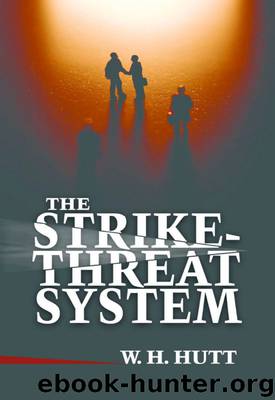The Strike-Threat System by W. H. Hutt

Author:W. H. Hutt [W. H. Hutt]
Language: eng
Format: epub
ISBN: 978-1-61016-135-0
Publisher: The Ludwig von Mises Institute
Published: 2009-11-06T16:00:00+00:00
NOTES
1 We must be careful not to exaggerate the extent to which, in practice, assets already provided in a given physical form are exploitable for such reasons. If only a tenth of the aggregate stock of assets has to be replaced on the average in each year, it still allows some considerable scope for modifications in the composition of the stock of assets over the course of, say, a decade.
2 See p. 131.
3 The substituted forms of assets may be of types which produce different kinds of output, that is, goods or services for which the required productive arrangements are less exploitable although the product stands lower on consumers’ scales of preference than those which would be preferred in a strike-free economy but for which the productive arrangements are relatively exploitable. Leisure may be one of the outputs.
4 There are exceptional circumstances. Sometimes the use of “the strike in detail” (“whipsaw”) appears to be good tactics (see p. 47), and on occasion discrimination against the more efficient firms is deemed advantageous (see pp. 153-155).
5 Curiously enough, Phelps-Brown and Hart (Economic Journal, 1952, pp. 269-73) have argued that, where prices of end products cannot be raised (or cannot be raised “proportionally”), the forcing up of labor costs means that unions can “squeeze profits” and hence cause redistribution in labor’s favor. But that is true only if the dynamic factors, to which the whole of this chapter is devoted, are ignored. I deal specifically with a model based on that assumption on pp. 136-137.
6 The word “unwilling” (in the sense of “coerced”) is justified when investors do not themselves benefit from the “joint monopoly.” But (as we are about to see) both may benefit and share the spoils.
7 W. H. Hurt, The Theory of Collective Bargaining (Glencoe, Ill.: Free Press, 1954), pp. 96-104. Such joint monopoly has, at times, had the express support of legal enactment. In the United States wage agreements in this category are often called “sweetheart contracts.”
8 In stressing the importance of prospective yields, it is important to perceive that current realized yields are most misleading at times—and business decision-makers have learned this truth through bitter experience. There can be no simple extrapolation of current yields to get prospective yields. Still less are the sales of one month simple evidence on which to forecast sales of subsequent months.
9 Tibor Scitovsky, “A Survey of Some Theories of Income Distribution,” National Bureau of Economic Research, The Behavior of Income Shares: Selected Theoretical and Empirical Issues. Studies in Income and Wealth (Princeton: Princeton University Press, 1964), p. 25.
10 Paul H. Douglas, Real Wage Rates in the United States. 1890-1926 (Boston: Houghton Mifflin Co., 1930), p. 567.
11 Melvin W. Reder, “Wage Structure Theory and Measurement,” Aspects of Labor Economics: A Conference of the Universities—National Bureau Committee for Economic Research, A Report of the National Bureau of Economic Research (Princeton: Princeton University Press, 1962), pp. 297-298.
12 The reader is reminded that by “excluded workers,” I refer to those who could have improved their incomes
Download
This site does not store any files on its server. We only index and link to content provided by other sites. Please contact the content providers to delete copyright contents if any and email us, we'll remove relevant links or contents immediately.
International Integration of the Brazilian Economy by Elias C. Grivoyannis(92164)
The Radium Girls by Kate Moore(11935)
Turbulence by E. J. Noyes(7943)
Nudge - Improving Decisions about Health, Wealth, and Happiness by Thaler Sunstein(7622)
The Black Swan by Nassim Nicholas Taleb(7016)
Rich Dad Poor Dad by Robert T. Kiyosaki(6414)
Pioneering Portfolio Management by David F. Swensen(6231)
Man-made Catastrophes and Risk Information Concealment by Dmitry Chernov & Didier Sornette(5926)
Zero to One by Peter Thiel(5693)
Secrecy World by Jake Bernstein(4653)
Millionaire: The Philanderer, Gambler, and Duelist Who Invented Modern Finance by Janet Gleeson(4386)
The Age of Surveillance Capitalism by Shoshana Zuboff(4216)
Skin in the Game by Nassim Nicholas Taleb(4165)
Bullshit Jobs by David Graeber(4101)
The Money Culture by Michael Lewis(4083)
Skin in the Game: Hidden Asymmetries in Daily Life by Nassim Nicholas Taleb(3935)
The Dhandho Investor by Mohnish Pabrai(3706)
The Wisdom of Finance by Mihir Desai(3659)
Blockchain Basics by Daniel Drescher(3511)
